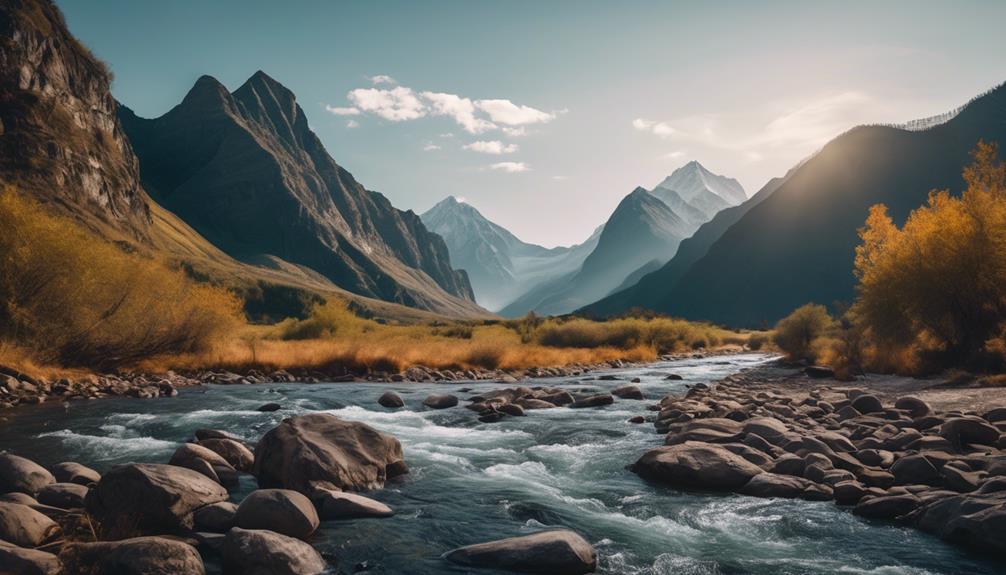Please note this post may contain affiliate links picked by me (Jay) that I have deemed may be of interest or relevant to you the reader of this.
These links do not affect the cost of the thing if you decide to purchase but i may get a little money if you choose to purchase.
For more information on my affiliate link policy click here.
Have you ever looked at a photograph and been captivated by its composition, wondering what makes it so visually appealing?
Well, let me let you in on a little secret: the Rule of Thirds. This simple guideline can make a world of difference in your photography, helping you create images that are balanced, dynamic, and engaging.
But why should you bother with this rule? In this discussion, I will unravel the mysteries of the Rule of Thirds and show you how it can elevate your photos to new heights.
So, grab your camera and get ready to discover the power of this fundamental principle.
Key Takeaways
- The Rule of Thirds improves composition and visual impact.
- Placing elements along the grid lines or intersections adds visual appeal and balance.
- Leading lines and framing techniques enhance depth and movement in photos.
- Breaking traditional rules and experimenting with unconventional compositions can lead to unique and impactful photographs.
Understanding the Rule of Thirds
To truly capture captivating and well-composed photos, it's essential to understand the concept of the Rule of Thirds. This fundamental principle is based on dividing an image into a grid system of nine equal parts by two horizontal and two vertical lines, creating four intersecting points. By placing key elements of your composition on or near these points, you can achieve a more visually appealing and balanced image.
The Rule of Thirds is one of the most important composition rules in photography, and understanding it can greatly enhance your ability to create impactful and innovative photographs. This rule encourages photographers to avoid placing their subject directly in the center of the frame, which can result in a static and less interesting image. Instead, it encourages you to place your subject off-center, creating a more dynamic and visually engaging composition.
By adhering to the Rule of Thirds, you can create a sense of balance and harmony in your photos. Placing your subject along one of the vertical lines can add a sense of depth and movement, while placing it on one of the intersecting points can draw the viewer's attention directly to the subject. This technique allows you to create a more visually interesting and compelling photograph.
Incorporating the Rule of Thirds into your photography not only helps you create visually appealing images but also encourages you to think outside the box and experiment with different compositions. By breaking away from the conventional centered composition, you can explore new and innovative ways to capture your subject, resulting in unique and captivating photographs.
Enhancing Balance and Symmetry
Enhancing balance and symmetry in your photos can elevate the overall aesthetic and visual impact of your composition. By incorporating these elements, you can create visually pleasing and captivating images that effectively convey your intended message. Here are three ways in which improving composition through balance and symmetry can enhance your visual storytelling:
- Creating harmony: The rule of thirds helps you place key elements off-center, resulting in a balanced composition that's visually appealing. By dividing your frame into nine equal parts, you can position your subject or points of interest along these lines or at their intersections. This technique adds a sense of harmony and balance to your image, drawing the viewer's eye to the focal point and creating a more engaging visual experience.
- Conveying stability: Balance and symmetry can evoke a sense of stability and order in your photos. When your composition is well-balanced, it creates a feeling of equilibrium, making the viewer feel more connected and engaged with the image. Symmetry, in particular, can be powerful in conveying a sense of calmness and tranquility, while also adding a touch of elegance to your photographs.
- Enhancing storytelling: Improving composition through balance and symmetry can amplify the storytelling aspect of your photos. By strategically placing key elements in your frame, you can guide the viewer's eye and create a narrative within your image. Whether it's a perfectly symmetrical landscape or a well-balanced portrait, these compositional techniques can help you convey the intended message more effectively and add depth to your visual storytelling.
Incorporating balance and symmetry into your photographs is a simple yet effective way to enhance the overall composition and visual impact. By utilizing the rule of thirds and understanding how these elements contribute to storytelling, you can create images that aren't only visually appealing but also compelling and engaging. So, next time you're behind the lens, don't forget to consider the power of balance and symmetry in improving your composition and telling a captivating visual story.
Creating Dynamic and Engaging Shots
Now let's explore how to capture dynamic and engaging shots that will truly captivate your audience and take your photography to the next level. When it comes to creating powerful images, incorporating leading lines and framing techniques can make all the difference. These techniques not only add depth and dimension to your photos but also guide the viewer's eye and create a sense of movement and excitement.
Leading lines are compositional elements that draw the viewer's attention towards the main subject of the photo. They can be anything from roads, fences, or even natural elements like rivers or tree branches. By positioning these lines strategically within your frame, you can create a visual pathway that guides the viewer's gaze and creates a dynamic and engaging composition. Experiment with different angles and perspectives to find the most effective leading lines for your shot.
Framing techniques, on the other hand, involve using elements within the scene to frame your subject. This could be arches, windows, or even foliage. By framing your subject, you not only add visual interest but also create a sense of depth and focus. It's like inviting your viewer to step into the photo and become part of the story. Don't be afraid to get creative and experiment with different framing options to find what works best for your particular shot.
To help you understand the impact of leading lines and framing techniques, take a look at the table below:
| Leading Lines | Framing Techniques |
|---|---|
| Curved road leading towards a sunset | Window frame framing a beautiful landscape |
| Pathway through a forest leading to a hidden waterfall | Archway framing a couple in a romantic pose |
| Railway tracks disappearing into the distance | Overhanging branches framing a child playing |
Directing the Viewer's Attention
Capturing the viewer's attention is essential in creating compelling and impactful photographs. As a photographer, I understand the importance of guiding the viewer's gaze and keeping them engaged with my work. This can be achieved through the strategic use of leading lines and focal points.
Here are three ways I direct the viewer's attention in my photographs:
- Leading Lines: By incorporating leading lines into my composition, I create a visual pathway that guides the viewer's eyes towards the main subject or focal point. These lines can be found in various elements such as roads, rivers, or architectural features. Utilizing leading lines adds depth and visual interest to the image, as well as helps to direct attention to the intended subject.
- Focal Points: Every photograph needs a clear and dominant focal point that immediately grabs the viewer's attention. Whether it's a person, an object, or a specific area of interest, the focal point serves as the visual anchor of the image. By positioning the focal point strategically within the frame, I ensure that it becomes the main point of focus and draws the viewer's attention instantly.
- Contrast and Color: Another effective way to direct the viewer's attention is by using contrast and color. By placing contrasting elements or vibrant colors near the focal point, I create visual interest and ensure that the viewer's eyes are drawn towards the intended subject. The contrast in tones or colors creates a visual hierarchy, emphasizing the focal point and keeping the viewer engaged.
Breaking the Rules for Artistic Impact
As a photographer, I've learned that sometimes breaking the traditional rules can lead to the most impactful and artistic photographs. It's in the moments when I experiment with unconventional compositions and explore alternative framing techniques that I truly push the boundaries of my creativity.
When it comes to experimenting with unconventional compositions, I often find myself drawn to asymmetry. Breaking away from the rule of thirds can create a sense of tension and intrigue in the frame. Placing the subject in an unexpected position, such as off-center or close to the edge, can add a dynamic element to the photograph. It challenges the viewer's expectations and forces them to engage with the image in a different way.
In addition to composition, exploring alternative framing techniques can also yield stunning results. Sometimes, I deliberately include elements in the foreground that partially obstruct the main subject. This technique, known as foreground framing, adds depth and layers to the photograph, creating a sense of mystery and exploration. It invites the viewer to actively explore the image and discover hidden details.
Breaking the rules for artistic impact requires a willingness to think outside the box and take risks. It's about pushing the boundaries of what's considered 'correct' or 'conventional' in photography. By experimenting with unconventional compositions and exploring alternative framing techniques, I've discovered a whole new world of artistic possibilities.
Frequently Asked Questions
How Does the Rule of Thirds Apply to Different Types of Photography, Such as Landscape, Portrait, or Still Life?
When it comes to photography, the rule of thirds is a game-changer. It enhances the composition of different types of photography by creating a visually pleasing balance.
Whether it's a landscape, portrait, or still life, applying the rule of thirds adds depth, interest, and a professional touch to your images.
Famous photographs like Ansel Adams' 'Moonrise, Hernandez' or Steve McCurry's 'Afghan Girl' effectively utilize this rule, showcasing its power in capturing captivating and innovative images.
Are There Any Exceptions or Situations Where the Rule of Thirds May Not Be the Best Composition Technique to Use?
When should photographers break the rule of thirds for more dynamic compositions?
Well, there are definitely situations where strict adherence to the rule may not be the best choice. Sometimes, breaking the rule can lead to more visually interesting and balanced compositions.
By exploring different techniques such as leading lines, symmetry, or framing, photographers can create captivating images that stand out from the crowd.
It's all about pushing the boundaries and finding innovative ways to capture the essence of a subject.
Can the Rule of Thirds Be Used Effectively in Post-Processing or Editing Software?
The rule of thirds in mobile photography is a game-changer. It allows me to create visually stunning compositions by placing key elements off-center.
But what if I want to enhance my composition further in post-processing? Can the rule of thirds be used effectively? Absolutely!
By aligning my subject and other elements with the gridlines, I can easily adjust and fine-tune the composition, making my photos even more captivating.
It's a powerful technique that takes my creativity to new heights.
Are There Any Alternative Composition Techniques That Can Be Used Alongside or Instead of the Rule of Thirds?
There are indeed alternative composition techniques that can be used alongside or instead of the rule of thirds.
One popular technique is called the golden ratio, which involves dividing the frame into asymmetrical sections.
Another technique is leading lines, where you use lines in the scene to guide the viewer's eye.
These alternative techniques offer different advantages and can bring a fresh perspective to your photos.
Exploring these options can lead to innovative and captivating compositions.
How Can Beginner Photographers Practice and Improve Their Use of the Rule of Thirds in Their Photographs?
To practice and improve my use of the rule of thirds, I experiment with creative angles and lighting techniques. By trying different perspectives and playing with light and shadows, I can create visually striking photos that adhere to this compositional rule.
It's a fun and innovative way to enhance the impact of my images and bring out their full potential. With practice and a bit of creativity, the rule of thirds becomes second nature, resulting in better photos every time.
Conclusion
In conclusion, the rule of thirds is a powerful tool that can transform your photos from ordinary to extraordinary. By understanding this technique and applying it in your compositions, you can achieve balance, create dynamic shots, and direct the viewer's attention to the most important elements.
But here's the secret: sometimes, breaking the rules can lead to astonishing artistic impact. So go ahead, experiment, and let your creativity soar.
Get ready to capture stunning images that will leave your audience breathless.


